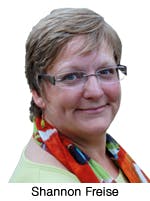Managing information technology demands is a key challenge for all businesses. Distributors are no exception, as they look for new and better ways to manage supplier and customer relationships. Earlier this spring, Global Purchasing asked Shannon Freise, vice president of information technology at electronic components distributor Sager Electronics, to weigh in on the increasingly complex world of technology and the supply chain.
Global Purchasing: What are some of the greatest technology challenges you face as a distributor today?
Shannon Freise: Distributors must be responsive to customers, suppliers, and manufacturers’ representatives. Speed of response and accuracy of information across all contact points are crucial to building trust and maintaining strong relationships. The greatest technology challenges facing business today revolve around the speed and accuracy of this information.
at Massachusetts-based distributor Sager Electronics
Global Purchasing: In what particular areas?
Freise: Communications: Smartphones, social media, texting, Twitter, and instant messaging have significantly changed how we communicate. Understanding the impact of these changes on the way we manage our business relationships adds an interesting dynamic since generational communication preferences also play a role.
Data management: Data, data everywhere and not a fact to use. Today’s organizations generate an enormous amount of data. Organizing, managing, maintaining, and mining pertinent facts is critical to getting the right information to the right people at the right time. For instance, Sager’s TIBCO ActiveMatrix software provides the ability to integrate data from multiple sources while actively communicating using Web APIs (application programming interfaces). By incorporating API technology, Sager has enhanced our ability to respond to customers with real-time information.
Regulation/compliance: Growing regulatory changes in the industry, such as conflict minerals, the rise of counterfeit parts, and increased export compliance regulations. Date coding is a hot industry topic due in large part to the issue of counterfeiting. Employing date code technology has allowed Sager to provide better product traceability to customers while helping Sager enforce our return policy. Today, we are better able to verify the product we shipped is the same product returned.
Upgrades: Over time, technology wears out or becomes obsolete and costly to support. Upgrading technology is important to stay competitive and keep employees working at maximum efficiency. It is critical that the timing of upgrades is balanced with overall stability, productivity, and cost of change.
Global Purchasing: What new technology tools have you added recently, and how are they designed to help customers?
Freise: Sager Electronics looks to technology to facilitate business transformation. Throughout the years, we’ve made wise investments that have allowed us to compete well in the market, and we’ve used technology to our advantage.
One such tool is our automated News2Know product notification e-mail system. While we are still looking to improve inbound information from our suppliers, feedback from those in the industry indicates our News2Know system is one of the most effective means available for communicating new products and product change notices to customers. Our News2Know PCN process improves traceability, looking at not only past purchases but also scheduled and forecasted buys to reach all possible [affected]customers.
Last year, Sager was the first distributor to fully adopt the new ECIA (Electronic Component Industry Association) guideline for outbound shipments. We integrated 2D bar coding on all of our outbound packing slips and product package labels. By doing so, we improved the quality and accuracy of information we provide to customers while giving them an opportunity to boost their receiving productivity.
This year, we are about to embark on the transformation of our intranet portal environment. By employing the latest in Microsoft SharePoint and Oracle PeopleSoft technologies, we will create an environment in which to provide our employees a collaborative platform to access tools such as our CRM (customer relations management).
Global Purchasing: Who is driving the technology changes in the electronics industry: the distributor, the end user, the component manufacturer, or a combination?
Freise: We see a combination of users driving technology changes in the electronics industry. The end user certainly [influences] technology with the push for improved system response times and better information to improve their productivity. Manufacturers and distributors alike continuously strive to find new ways to improve collaboration, often creating private solutions. Industry associations like ECIA are working with the manufacturing and distribution communities to help respond to the challenges and create uniform standards. However, all of this takes time to not only develop, but also integrate and adopt standards across the channel.
Global Purchasing: How difficult is it to keep up with changing technology demands today? How does this compare to just five or 10 years ago?
Freise: The rapid innovation cycle and affordable 3D printing fueled by crowdfunding are creating a very fertile environment for bringing a multitude of new technologies to market. Combine this with the affordability of handheld technologies and the number of apps available to smartphone consumers at little to no cost and you have a sea change. As little as four years ago we saw our end users asking us what technology they should use at home. Today, we have more of our end users asking us to bring their consumer-based technology to the office. With so many more options available, more time is spent researching solutions. At Sager, we take all of these evolving technology demands into consideration, but our investments have been and continue to be driven by solid business return-on-investment. We have never been a technology for technology’s sake player.
Global Purchasing: Aside from technology, what are the other key challenges distributors such as Sager are facing in 2014?
Freise: Reliability, the speed of response, and the flow of information are our biggest challenges. Product changes and obsolescence, compliance, and environmental issues around conflict minerals, REACH (Registration, Evaluation, Authorization, and Restriction of Chemical Substances), and RoHS (Restrictions on Hazardous Substances) challenge today’s customers, and therefore challenge us. Sager continues to make investments to address our customers’ needs—enhancing our tools and our data for reliable, informative, and quick responses.









